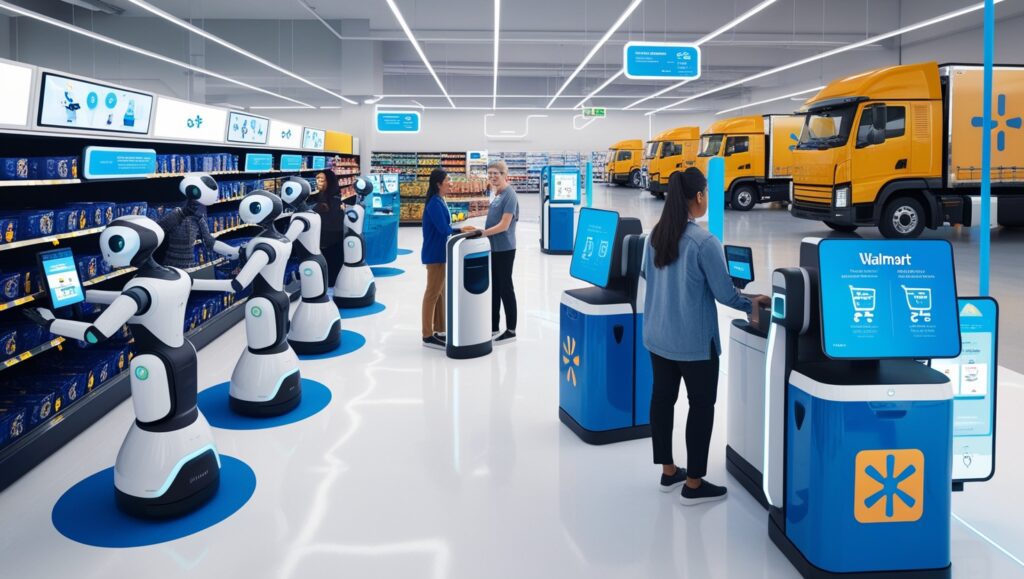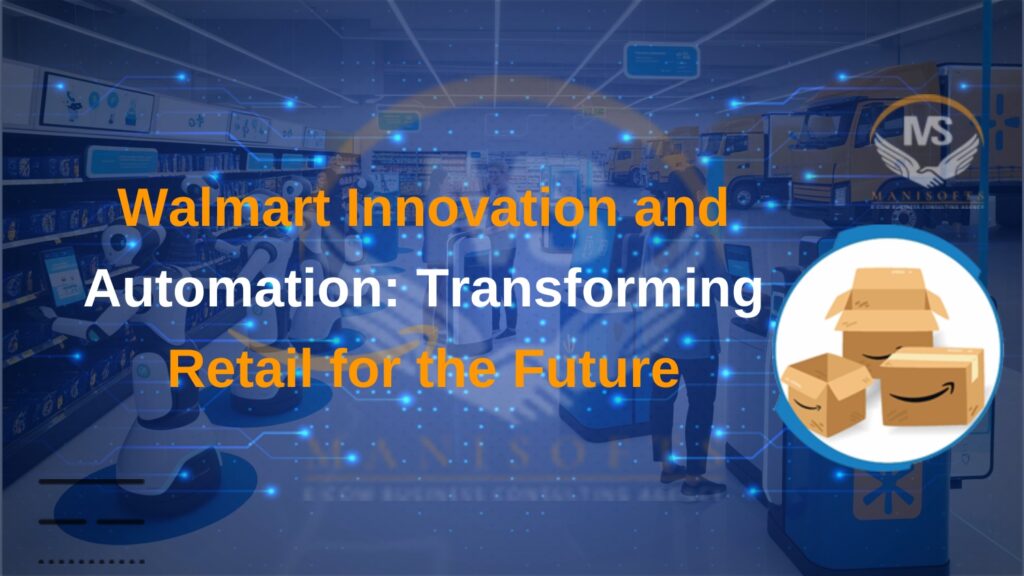Learn how Walmart Innovation and Automation is a retail industry pioneer implementing new progressive methods and utilizing automation. Read more about their innovations in supply chain management, store operations, and e-commerce, improving client satisfaction and productivity. Know more about Walmart’s sustainability index and the future of retailing.
Introduction
Walmart was established in 1962 in Arkansas and is today’s largest retail organization, with over 10,000 stores worldwide. Offering the customers products at rather low costs, Walmart currently exists as a supercenter and an electronic market and continues to expand its e-commerce facilities, helping millions of clients.
Competitive pressures require organizations to innovate in today’s fast-changing retail context. The industry has witnessed the use of automation, robotics and AI through such aspects. The world’s largest retailer, Walmart, has embraced technology to help it cut costs, improve customer satisfaction and satisfy the increasing demand for convenience. The retail company has successfully implemented these technologies as a pioneer, thus achieving a competitive advantage and effectively charting the future of retailing.
Walmart Innovation and Automation
Walmart, one of the largest retail giants in the world, is constantly evolving to meet the needs of its customers in an ever-changing market. A major part of this evolution involves innovation and automation, two key drivers behind Walmart’s ongoing efforts to streamline operations, improve customer experience, and maintain its competitive edge. By embracing cutting-edge technology, Walmart has transformed traditional retail processes, making them faster, more efficient, and customer-centric.
1. Automation in Supply Chain and Logistics
Walmart’s supply chain is the backbone of its global retail network, and automation significantly optimizes this system. By integrating advanced robotics and artificial intelligence (AI), Walmart has been able to automate many aspects of its supply chain, from warehouse operations to transportation logistics.
- Automated Warehouses: Walmart has implemented robotics to handle tasks such as picking, sorting, and packing items in its distribution centers. This speeds up the process and reduces human error, ensuring that products reach stores and customers faster and more accurately.
- Autonomous Trucks: Walmart is experimenting with self-driving trucks to transport goods between distribution centers. This innovation aims to improve delivery efficiency, reduce costs, and address driver shortages in the trucking industry.
2. In-Store Automation
Walmart has also introduced automation within its stores to enhance the shopping experience and improve operational efficiency.

- Self-Checkout Stations: One of Walmart’s most visible innovations in-store is the rollout of self-checkout kiosks. These allow customers to scan and pay for items themselves, reducing wait times and improving the flow of customers during peak shopping hours.
- Automated Shelf Scanning: To keep shelves stocked and ensure product availability, Walmart uses robots to scan shelves for out-of-stock items, pricing errors, and misplaced products. This automated system helps employees prioritize restocking, ensuring customers always find their needs.
3. E-Commerce and Digital Innovation
In addition to transforming its physical stores, Walmart has made significant strides in the digital space, utilizing automation and innovative technology to enhance its e-commerce offerings.
- Walmart+ and Online Shopping: With the rise of online shopping, Walmart has introduced services like Walmart+, a membership program that offers benefits such as free delivery, fuel discounts, and early access to sales. To support this, Walmart has automated its e-commerce infrastructure, including order fulfillment and delivery logistics.
- Online Grocery Pickup and Delivery: Walmart’s online grocery shopping service has become increasingly popular. The company has invested in automated fulfillment centers to speed up the processing of online orders and ensure faster, more accurate delivery or curbside pickup for customers.
4. AI and Machine Learning for Personalization
Walmart is also harnessing the power of artificial intelligence (AI) and machine learning to understand customer behavior better and personalize their shopping experience.
- Product Recommendations: Using AI, Walmart’s online platform analyzes customer shopping patterns to provide personalized product recommendations. This enhances the shopping experience and encourages customers to explore new products based on their preferences.
- Demand Forecasting: AI and machine learning help Walmart predict product demand more accurately, ensuring that stores are stocked with the right products at the right time. This reduces waste, lowers costs, and allows customers to find their needs.
5. Sustainability Through Innovation
Walmart’s innovation isn’t just about improving efficiency—it’s also about making retail more sustainable. The company has committed to reducing its environmental footprint by investing in energy-efficient technologies and automation.
- Renewable Energy and Smart Energy Management: Walmart has integrated automation in energy management systems to monitor and optimize energy use in its stores. Additionally, the company is investing in renewable energy sources such as solar and wind power to reduce its carbon footprint.
- Sustainable Packaging: Through AI-driven analytics, Walmart is identifying ways to reduce excess packaging in its supply chain, using more sustainable materials and minimizing waste.
6. The Future of Walmart’s Innovation and Automation
Looking forward, Walmart’s commitment to innovation and automation will only deepen. The company is exploring technologies like drone delivery, cashierless stores, and even virtual shopping experiences to further enhance convenience for customers. By continuously investing in advanced technology, Walmart is positioning itself to meet the challenges of modern retail and create a more seamless and efficient shopping experience for its customers.
FAQ’s
How has Walmart integrated automation into its supply chain?
Currently, Walmart has adopted automation through robotics in the warehouses and distribution centers it services through using Automated Guided Vehicles (AGVs) for transportation and AI inventory management systems. These have facilitated operations, increased efficiency and decreased overall costs.
What technologies are used in Walmart stores to enhance customer experience?
Walmart uses automated checkouts such as self-checkout kiosks, smart shelves for tracking inventories in real-time, and mobile applications for browsing and purchasing and customized promotions. They also provide convenience to customers as they shop by synchronizing their purchases with their day plans.
How does Walmart’s e-commerce strategy incorporate automation?
Walmart has installed rapid online order processing facilities called fulfillment centers and emerging technologies such as drones. This integration’s benefits include flexible delivery and pick-up points for the end consumers.
What role does sustainability play in Walmart’s innovation strategy?
The specific topics regarding sustainability at Walmart include using renewable energy sources in business activities, management of sustainable packaging principles and minimization of waste. Automation also plays a role in decreasing the environmental impact as it facilitates the appropriate usage of resources and improves their effective utilization.
What future trends can we expect from Walmart regarding innovation and automation?
Key technology trends that Walmart has adopted may include The probability that Walmart will launch innovations such as blockchain for transparency in the supply chain and augmented reality for user experience in shopping. Further, a threat is associated with job automation, workforce employment, and ethical dilemmas central to AI and data privacy.
Conclusion
The consistent resourceful effort the company has put down in the technological area has made Walmart one of the world’s leading retail giants. Information technology in Walmart’s supply chain, self-operations, online store and social responsibility has improved their operations’ performance, satisfaction and cost.
Such changes allow the company to outpace rivals and create the basis for future development against the background of the continuous technological advance of the retail industry. As Walmart actively seeks new ways of developing its retail future possibilities based on such trends as AI, blockchain, drone delivery, etc., the company is equipped with all the tools necessary to take advantage of the next retail revolution while considering the aspects of sustainability and ethical standards in the practice of its operations.




